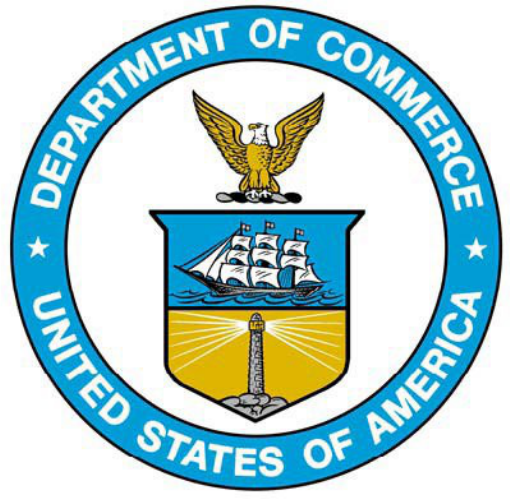
Version Number: 01-2021
U.S. Department of Commerce
National Oceanic & Atmospheric Administration
Privacy Threshold Analysis
for the
NOAA8850
Enterprise Mission Enabling System (EMES)

Version Number: 01-2021
2
U.S. Department of Commerce Privacy Threshold Analysis
NWS Enterprise Mission Enabling System (EMES)
Unique Project Identifier: NOAA8850
Introduction: This Privacy Threshold Analysis (PTA) is a questionnaire to assist with
determining if a Privacy Impact Assessment (PIA) is necessary for this IT system. This PTA
is primarily based from the Office of Management and Budget (OMB) privacy guidance and
the Department of Commerce (DOC) IT security/privacy policy. If questions arise or further
guidance is needed in order to complete this PTA, please contact your Bureau Chief Privacy
Officer (BCPO).
Description of the information system and its purpose: Provide a brief description of the
information system.
The E-Government Act of 2002 defines “information system” by reference to the definition section of Title 44 of the United States Code. The
following is a summary of the definition: “Information system” means a discrete set of information resources organized for the collection,
processing, maintenance, use, sharing, dissemination, or disposition of information. See: 44. U.S.C. § 3502(8).
The NWS Enterprise Mission Enabling System (EMES) is defined as a group of complementary
enterprise services that provide a secure and reliable infrastructure throughout the NWS organization.
EMES consists of Microsoft Active Directory (AD), McAfee ePolicy Orchestrator (ePO), Centralized
Certificate Authority (CCA), and Enterprise Cybersecurity Monitoring and Operations (ECMO). Each of
these separate products work together to provide authentication, security, reliability, inventory and an
overall continuity of enterprise service for NWS staff. These tools ensure that only properly identified
network devices connect to the NWS Network; run the latest software; run in a secure environment; and
only properly identified and authorized NWS staff gain network access. The system employs
redundancy to ensure reliability and availability while reducing latency and bandwidth.
The following application contains PII/BII in the operation and development systems. (NOAA8850
is responsible for the development side of MARS)
MARS is a web-based financial management and reporting system that was created to serve all financial
and administrative components of the National Oceanic and Atmospheric Administration (NOAA).
MARS is an automated system for collecting, storing, and retrieving information concerning the
financial activities of the Financial Management Centers (FMC's) in NOAA, as well as the Workforce
Management information. NOAA financial information is entered into the MARS system through
various sources where it is processed and stored. Management and administrative personnel then retrieve
this information in the form of reports for analysis. The MARS Development System is an OLAP/ETL
development environment used for on-going design, development and testing of new reporting
and querying modules, for eventual deployment to Pre-Production and Production in the MARS
Reporting and Querying Module.
Address the following elements:

Version Number: 01-2021
3
a)
Whether it is a general support system, major application, or other type of system
EMES is a General Support System (GSS)
b)
System location
EMES is located at 1325 East-West Hwy Silver Spring, MD 20910 (SSMC2)
c)
Whether it is a standalone system or interconnects with other systems (identifying and
describing any other systems to which it interconnects)
EMES has interconnections with other NWS/NOAA FISMA IDs, including
NOAA0900- Cloud App
NOAA1011-ITC
NOAA8100- CBITS
NOAA8106-UAOS
NOAA8107-AWIPS
NOAA8202-OWP
NOAA8203-N-PMS
NOAA8860-WCCIS
NOAA8872-MDLNet
NOAA0550-N WAVE
All of NWS Region Headquarters (Alaska Region – NOAA8880, Central Region – NOAA8881,
Eastern Region – NOAA8882, Pacific Region – NOAA8883, Southern Region – NOAA8884,
Western Region – NOAA8885)
PII data is only shared with NOAA1011-ITC
d)
The purpose that the system is designed to serve
EMES provide enterprise services and a reliable infrastructure throughout the NWS organization.
Also, provides network infrastructure support, management, and connectivity services to the
desktop and server customers within the NOAA8850 accreditation boundary, for administrative
functions.
e)
The way the system operates to achieve the purpose
The NWS Enterprise Mission Enabling System (EMES) is defined as a group of complementary
enterprise services that provide a secure and reliable infrastructure throughout the NWS
organization. EMES consists of Microsoft Active Directory (AD), McAfee ePolicy Orchestrator
(ePO), Centralized Certificate Authority (CCA), and Enterprise Cybersecurity Monitoring and
Operations (ECMO). Each of these separate products work together to provide authentication,
security, reliability, inventory and an overall continuity of enterprise service for NWS staff. These

Version Number: 01-2021
4
tools ensure that only properly identified network devices connect to the NWS Network; run the
latest software; run in a secure environment; and only properly identified and authorized NWS staff
gain network access. The system employs redundancy to ensure reliability and availability while
reducing latency and bandwidth.
NOAA8850 provides network infrastructure support, management, and connectivity services to the
desktop and server customers within the NOAA8850 accreditation boundary, for administrative
functions to include:
• Service Desk support,
• Active Directory (AD) services,
• File and print services
• File backup and restoration,
• Network Attached Storage (NAS)
• Dynamic Host Configuration Protocol (DHCP) and IP address space allocation
• Windows Internet Name Services (WINS)
• Domain Name Service (DNS),
• Application distribution and patch management,
• Backup and disaster recovery
In addition, it provides system-level support for servers, desktop computers/workstations, and
laptops; and a test lab for systems and network engineers to develop and test new technologies, and
to pre-configure new equipment for deployment. Lastly, the NOAA8850 AD user base receives
electronic mail and calendar services from the NOAA Messaging Operations Center.
Microsoft Active Directory
Microsoft Active Directory is a special purpose database that authenticates and authorizes all users
and computers in a Windows domain network. It is responsible for assigning and enforcing security
policies for all computers. Active Directory checks the submitted password and authorizes user
access to the system. Multiple Domain Controllers maintain copies of the AD Database and provide
redundancy if another Domain Controller is unavailable. Domain Controllers are located in
regional offices and key field offices to provide user access and reduce bandwidth.
McAfee ePolicy Orchestrator (ePO)
McAfee ePolicy Orchestrator is an integrated security software program designed to integrate the
numerous security programs and to provide real time monitoring of security programs through a
single console. McAfee EPO provides end-to-end visibility with a unified view of your security
posture, simplified security operations, real-time security status, and an open architecture enabling
faster response times.
Enterprise Cybersecurity Monitoring and Operations (ECMO)
The ECMO provides essential, near real-time security status and remediation, increasing visibility
into system operations and helping security personnel make risk-management decisions based on
increased situational awareness. ECMO provides performance metrics to support the administration
priority performance areas of continuous monitoring, automated asset management, automated
configuration management, and automated vulnerability management.
Centralized Certificate Authority (CCA)

Version Number: 01-2021
5
Centralized Certificate Authority issues certificates for day-to-day encryption needs, for encrypting
local files and file systems, encrypting the communications between client workstation and servers,
as well as server-to-server communication encryption. NOAA8850 utilizes 9 separate types of
encryption for protecting information in transit and at rest. The nature of the encryption varies
depending on the user need for access to the data, the sensitivity of the data, and the nature of the
data being encrypted.
NOAA8850 also includes the National Weather Service Headquarters Local Area Network
Infrastructure, which consists of domain controllers, servers, desktop/workstation, laptops, printers
and network infrastructure components and supports approximately 130 users and 380 network
devices.
The Radar Product Improvement System (RPI)
The Radar Product Improvement System (RPI) is defined as a testing and development platform for
new functionality within Radar Product Generator (RPG), Supplemental Product Generator (SPG)
and Advanced Weather Interactive Processing System (AWIPS). Its mission is to aide in the
evolution of NOAA’s NWS as an agile agency supporting emergency managers, first responders,
government officials, businesses, and the public. The strategy is to improve the accuracy and
usefulness of forecasts. To do so, RPI provides live radar data feeds from the Air Route
Surveillance Radar System (ARSR-4) located in Guantanamo Bay, Cuba, and maintained by the
Federal Aviation Administration (FAA). The ARSR-4 - for RPI purposes - provides weather
processing capabilities levied by RPI to generate Radar products for AWIPS testing. RPI ingests
Level 2 radar data from ARSR-4 and generates Level 3 radar products. All data is categorized by
FIPS 199 as “Environmental Monitoring and Forecasting”.
The National AWIPS Program Office (NAPO)
The National AWIPS Program Office (NAPO) mission is to support activities related to the
development of the Advanced Weather Interactive Processing System (AWIPS). Build Servers
compile code and ingest live data to assist in the AWIPS process. As a development environment,
NAPO provides build machines for fabricating test Redhat Package Manager (RPMS) and a
Network Attached Server (NAS) for backup storage and shared storage.
NAPO features the implementation of live data feeds that support a wide variety of development
projects and configurations. The NAPO systems makes available to its developers a live
NOAAport SBN feed and a feed from the Ground Segment, over which live weather satellites,
GOES16 and GOES17, GOES rebroadcast (GBR) space packets are received.
MYPS
The Multi Year Planning System (MYPS) now referred to as Enterprise Resource Integration Team
(ERIT) is comprised of two General Services Systems (GSS) and includes 20 servers (CFO1
servers); the RIMS Labor Projection Model and the Management Analysis and Reporting System
BI Maintenance Platform (MARS). The RIMS Labor Projection Model is an operational system
and MARS BI Maintenance Platform is used only for maintenance efforts related to the production

Version Number: 01-2021
6
and pre-production MARS systems which are housed at the NOAA1011- Information Technology
Center.
The Resource Information Management System (RIMS) is a tool used to compute the multi-year
total NWS labor five-year model using a detailed site-by-site, bottom-up cost approach. It
calculates labor costs by site by position with the impact of changes in staffing levels. The model
applies a labor lapse, calculates FTE, benefits, premium pay (shift differential), overtime, locality
pay, COLA, special IT pay, awards, and annual pay raises. Costs are calculated using OPM-
published salary and rates tables. All costs are categorized by ACCS, cost category, funding source,
and portfolio. In addition, the model is used in “what-if” analyses to answer questions about
proposed changes in labor such as lapse, labor rates, inflation, and table of organization changes.
The resulting five-year answer sets are used to answer detailed questions about labor planning for
NWS, NOAA, DOC, OMB, and Congressional requests. The labor data contained in the model’s
database is the master authorized (funded) position data for NWS. RIMS does not contain any
PII/BII information.
The following application contains PII/BII in the operation and development systems.
(NOAA8850 is responsible for the development side of MARS)
MARS is a web-based financial management and reporting system that was created to serve all
financial and administrative components of the National Oceanic and Atmospheric Administration
(NOAA). MARS is an automated system for collecting, storing, and retrieving information
concerning the financial activities of the Financial Management Centers (FMC's) in NOAA, as well
as the Workforce Management information. NOAA financial information is entered into the MARS
system through various sources where it is processed and stored. Management and administrative
personnel then retrieve this information in the form of reports for analysis. The MARS
Development System is an OLAP/ETL development environment used for on-going design,
development and testing of new reporting and querying modules, for eventual deployment to
Pre-Production and Production in the MARS Reporting and Querying Module.
f)
A general description of the type of information collected, maintained, used, or disseminated
by the system
MARS collect the following information types from Federal employees and contractors:
General Personal Data (Names, Gender, Age, Military Service, DOB, Home Address, Home
telephone number, Email, and Education)
Worked-Related Data (Occupation, Job Title, Salary, Work address, Telephone Number, And
Work Email,
System Administration/Audit Data (User ID, IP Address, Date/Time of Access, and Queries Run)
g)
Identify individuals who have access to information on the system
Federal employees and contractors with a NOAA CAC or NOAA email account have access to
the information in the system.

Version Number: 01-2021
7
h)
How information in the system is retrieved by the user
The MARS Reporting & Querying module is available on the internet. Access to the MARS Data
Entry module requires a connection to the NOAA VPN with a Government Furnished Equipment
(GFE). Each Account is for the individual use of an identified employee or contractor of NOAA.
Accounts remain valid for the duration the individual maintains the relevant status within their
organization.
i)
How information is transmitted to and from the system
Information transmitted to and from the system is via the NOAA 0550 N-Wave\TICAP system. If a data
transmission involves a privacy consideration, an EMES employee would use the DOC provided secure
file transmission system. EMES employee personnel recommend the DOC secure file transfer method as
standard practice to receive sensitive data into the system Data on laptops are encrypted at rest using
AES-256. Sensitive Data, such as PII, is transmitted via Kiteworks using AES-256 encryption.
Questionnaire:
1. Status of the Information System
1a. What is the status of this information system?
This is a new information system. Continue to answer questions and complete certification.
This is an existing information system with changes that create new privacy risks.
Complete chart below, continue to answer questions, and complete certification.
Changes That Create New Privacy Risks (CTCNPR)
a. Conversions
d. Significant Merging
g. New Interagency Uses
b. Anonymous to Non- Anonymous
e New Public Access
h. Internal Flow or
Collection
c. Significant System Management
Changes
f. Commercial Sources
i. Alteration in Character
of Data
j. Other changes that create new privacy risks (specify):
This is an existing information system in which changes do not create new privacy
risks, and there is not a SAOP approved Privacy Impact Assessment. Continue to answer
questions and complete certification.
X This is an existing information system in which changes do not create new privacy
risks, and there is a SAOP approved Privacy Impact Assessment. Skip questions
and complete certification.

Version Number: 01-2021
8
1b. Has an IT Compliance in Acquisitions Checklist been completed with the appropriate
signatures?
Yes. This is a new information system.
Yes. This is an existing information system for which an amended contract is needed.
No. The IT Compliance in Acquisitions Checklist is not required for the acquisition
of equipment for specialized Research and Development or scientific purposes that
are not a National Security System.
No. This is not a new information system.
2. Is the IT system or its information used to support any activity which may raise privacy
concerns?
NIST Special Publication 800-53 Revision 4, Appendix J, states “Organizations may also engage in activities that do not involve the
collection and use of PII but may nevertheless raise privacy concerns and associated risk. The privacy controls are equally applicable to
those activities and can be used to analyze the privacy risk and mitigate such risk when necessary.” Examples include, but are not limited
to, audio recordings, video surveillance, building entry readers, and electronic purchase transactions.
Yes. (Check all that apply.)
Activities
Audio recordings
Building entry readers
Video surveillance
Electronic purchase transactions
Other (specify):
No.
3. Does the IT system collect, maintain, or disseminate business identifiable information (BII)?
As per DOC Privacy Policy: “For the purpose of this policy, business identifiable information consists of (a) information that is defined in
the Freedom of Information Act (FOIA) as "trade secrets and commercial or financial information obtained from a person [that is]
privileged or confidential." (5 U.S.C.552(b)(4)). This information is exempt from automatic release under the (b)(4) FOIA exemption.
"Commercial" is not confined to records that reveal basic commercial operations" but includes any records [or information] in which the
submitter has a commercial interest" and can include information submitted by a nonprofit entity, or (b) commercial or other information
that, although it may not be exempt from release under FOIA, is exempt from disclosure by law (e.g., 13 U.S.C.).”
____ Yes, the IT system collects, maintains, or disseminates BII.
No, this IT system does not collect any BII.
4. Personally Identifiable Information (PII)
X
X
X

Version Number: 01-2021
9
4a. Does the IT system collect, maintain, or disseminate PII?
As per OMB 17-12: “The term PII refers to information that can be used to distinguish or trace an individual’s identity either alone or when
combined with other information that is linked or linkable to a specific individual.”
Yes, the IT system collects, maintains, or disseminates PII about: (Check all that
apply.)
DOC employees
Contractors working on behalf of DOC
Other Federal Government personnel
Members of the public
No, this IT system does not collect any PII.
If the
answer is “yes” to question 4a, please respond to the following questions.
4b. Does the IT system collect, maintain, or disseminate Social Security numbers (SSNs),
including truncated form?
Yes, the IT system collects, maintains, or disseminates SSNs, including truncated
form.
Provide an explanation for the business need requiring the collection of SSNs, including
truncated form.
Provide the legal authority which permits the collection of SSNs, including truncated form.
No, the IT system does not collect, maintain, or disseminate SSNs, including
truncated form.
4c. Does the IT system collect, maintain, or disseminate PII other than user ID?
Yes, the IT system collects, maintains, or disseminates PII other than user ID.
No, the user ID is the only PII collected, maintained, or disseminated by the IT
system.
4d. Will the purpose for which the PII is collected, stored, used, processed, disclosed, or
disseminated (context of use) cause the assignment of a higher PII confidentiality impact
X
X
X
X
X

Version Number: 01-2021
1
level?
Examples of context of use include, but are not limited to, law enforcement investigations, administration of benefits, contagious disease
treatments, etc.
Yes, the context of use will cause the assignment of a higher PII confidentiality
impact level.
No, the context of use will not cause the assignment of a higher PII confidentiality
impact level.
If any of the answers to questions 2, 3, 4b, 4c, and/or 4d are “Yes,” a Privacy Impact Assessment (PIA)
must be completed for the IT system. This PTA and the SAOP approved PIA must be a part of the IT
system’s Assessment and Authorization Package.
X

Version Number: 01-2021
1
CERTIFICATION
X The criteria implied by one or more of the questions above apply to the NOAA8850 and
as a consequence of this applicability, a PIA will be performed and documented for this IT
system.
The criteria implied by the questions above do not apply to the NOAA8850 and as a consequence
of this non-applicability, a PIA for this IT system is not necessary.
Information System Security Officer or
System Owner
Name: De Shawn Lewis
Office: NWS
Phone: 301-427-6994
Email: Deshawn.lewis@noaa.gov
Information Technology Security Officer
Name: Andrew Browne
Office: NWS
Phone: 301-427-9033
Email: Andrew.browne@noaa.gov
I certify that this PIA is an accurate representation of the security
controls in place to protect PII/BII processed on this IT system.
I certify that this PIA is an accurate representation of the security
controls in place to protect PII/BII processed on this IT system.
Signature: Signature:
Date signed: Date signed:
Privacy Act Officer
Name: Adrienne Thomas
Office: NOAA OCIO
Phone: 828-257-3148
Email: [email protected]
Authorizing Official
Name: Beckie Koonge
Office: NWS
Phone: 301-427-9020
Email:[email protected]
I certify that the appropriate authorities and SORNs (if applicable)
are cited in this PIA.
I certify that this PIA is an accurate representation of the security
controls in place to protect PII/BII processed on this IT system.
Signature: Signature:
Date signed: Date signed:
Bureau Chief Privacy Officer
Name: Mark Graff
Office: NOAA OCIO
Phone: 301-628-5658
Email: [email protected]
I certify that the PII/BII processed in this IT system is necessary
and this PIA ensures compliance with DOC policy to protect
privacy.
Signature:
Date signed:
This page is for internal routing purposes and documentation of approvals. Upon final
approval, this page must be removed prior to publication of the PTA.
BROWNE.ANDRE
W.PATRICK.14721
49349
Digitally signed by
BROWNE.ANDREW.PATRICK.1
472149349
Date: 2022.03.24 13:08:47 -04'00'
LEWIS.DESHAWN.
TYRELL.151028654
1
Digitally signed by
LEWIS.DESHAWN.TYRELL.1510
286541
Date: 2022.03.24 10:34:28 -04'00'
KOONGE.BECKI
E.A.1408306880
Digitally signed by
KOONGE.BECKIE.A.1408306880
Date: 2022.03.28 15:29:34 -04'00'
GRAFF.MARK.HY
RUM.1514447892
Digitally signed by
GRAFF.MARK.HYRUM.1514447
892
Date: 2022.04.05 15:35:30 -04'00'
THOMAS.ADRIEN
NE.M.1365859600
Digitally signed by
THOMAS.ADRIENNE.M.1365859
600
Date: 2022.03.29 13:03:35 -05'00'
